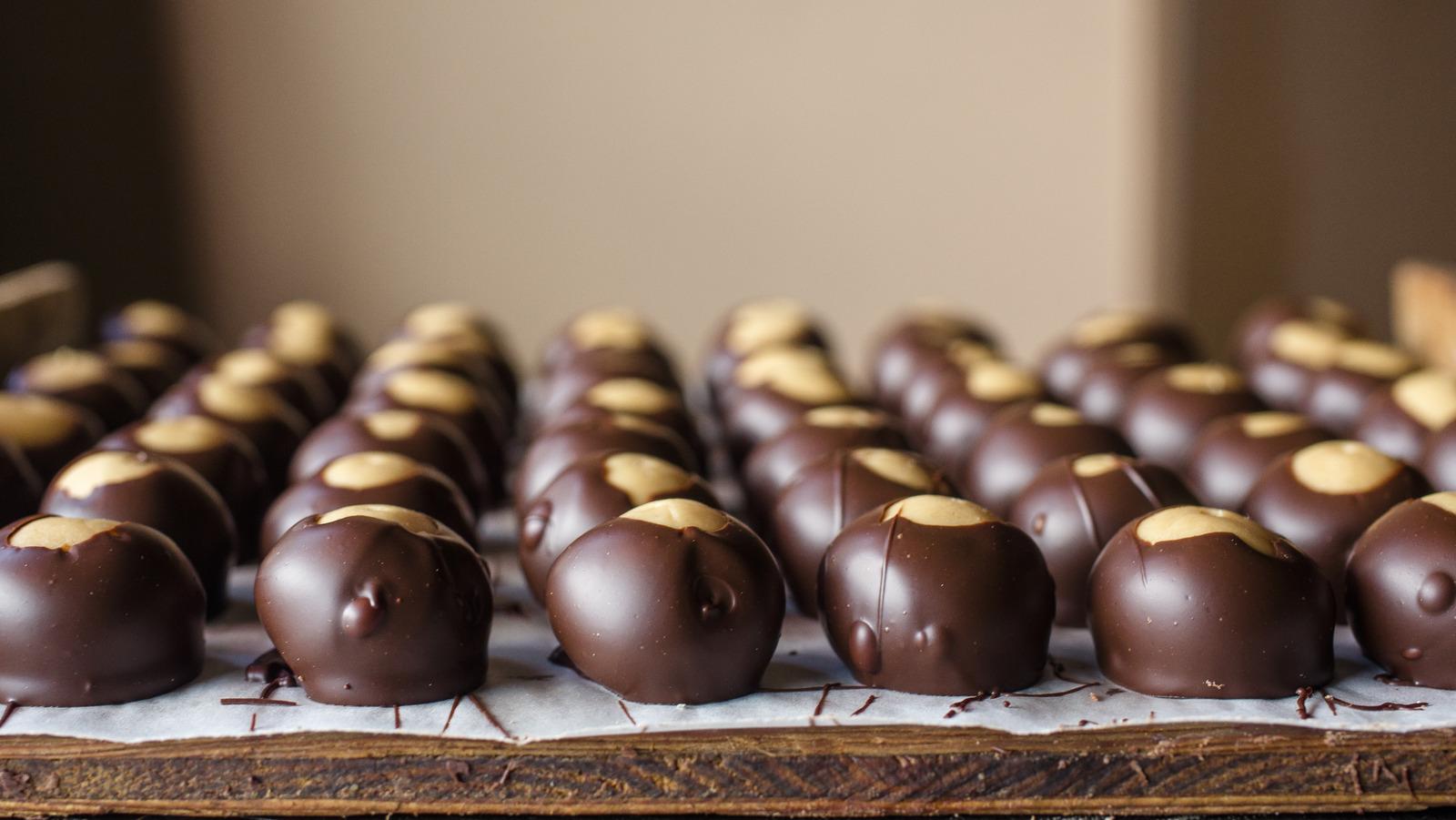
Cavan Images/Getty Images
The Midwest is reflective of the United States in that it is very much a melting pot. It's made up of people from different cultures, many of whom have brought their recipes to the region. Some of these recipes have been around since the very beginning of statehood, and, at some point, became a staple of the Midwest. However, while many classic Midwestern desserts have roots in other parts of the world, the region has come up with some of its very own iconic sweet treats. The result of borrowed and crafted recipes has helped create a distinct culinary culture that is wholly unique.
From centuries-old European recipes to Jell-O-infused gems of the U.S., the Midwest is packed with delicious desserts that still grace tabletops today. Passed down from generation to generation, the staying power of these classic sweets is ingrained in Midwestern culture. Whether made in home kitchens or bought in stores, these old-school desserts can still be found in the Midwest and will likely be around for generations to come.
Kuchen
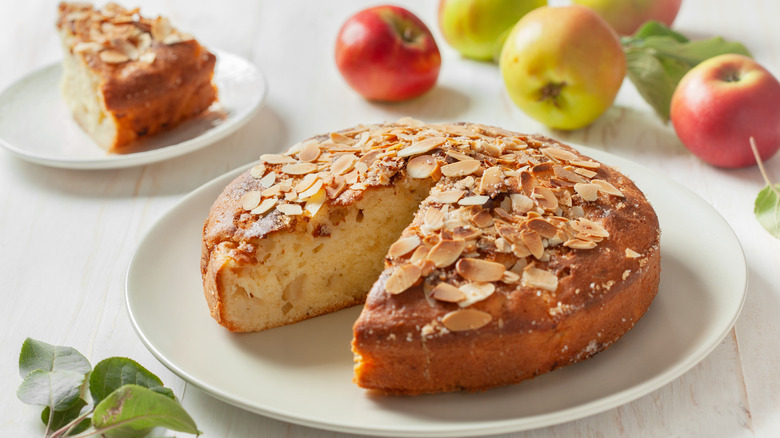
Natashamam/Getty Images
Kuchen is the German word for cake, but it isn't a direct parallel to the cake most Americans are used to eating, and it looks a lot different. You won't find an frosting-coated, layered dessert when presented with kuchen. Instead, the Midwestern dish is rooted in German and Russian heritage and is like a cake-pie hybrid.
Picture a pie, replace the crust with cake, and you've got a good idea of what kuchen is. In some cases, you can picture a single-tiered cake dotted with fruit or nuts to get a good idea of what the dish looks like. Even though icing isn't a characteristic of traditional kuchen, the dessert still has a subtle sweetness. Between the fruity flavor, custard filling, and the option of topping it off with whipped cream, there is more than enough sweetness in the dish to sate a sweet tooth.
Kuchen is the official state dessert of South Dakota, showcasing how popular and ingrained the dessert is in local culture. It is usually made for special occasions and gatherings, but can also be a regular household dessert that has been passed down from older generations.
Frozen custard

Rimma Bondarenko/Shutterstock
Although this sweet treat was created in New York, frozen custard is largely associated with the Midwest. This is because while New York may have moved on to other desserts, the Midwest stayed devoted to frozen custard. It makes sense why it would stay so loyal, seeing as some of the best frozen custard spots in America have stood strong in the Midwest.
The primary difference between frozen custard and ice cream is eggs. Frozen custard incorporates egg yolks, kind of like how frozen yogurt uses, well, yogurt. The difference is reflected in the texture and richness of flavor of the frozen treats. Milwaukee, Wisconsin, is often thought of as a frozen custard powerhouse, thanks in no small part to its thriving dairy industry. Kopp's Frozen Custard and Gilles Frozen Custard are two standbys in the city. It's not just Wisconsin that is hot for frozen custard in the Midwest, though, with a Ted Drewes Frozen Custard location in St. Louis, Missouri, serving as a popular stop on Route 66. Culver's, which some see as the trophy of the Midwest's fast food scene, also keeps frozen custard as a staple on its menu.
Buckeyes
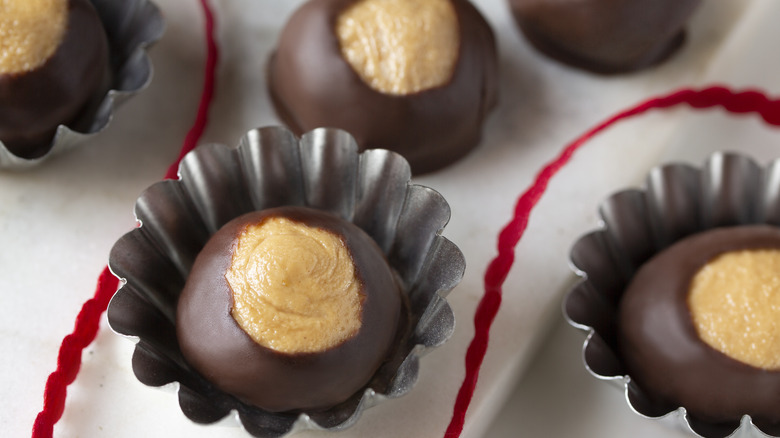
Photokitchen/Getty Images
If there is one Midwestern dessert that has become a beloved sweet treat beyond the region, it's buckeyes. The sweet treat can be dated back to 1919, when it was largely sold at Ohio State football games. The bite-sized, chocolate-coated peanut butter balls are staples around holidays and the perfect treat for gift-giving.
Ohio is known as the Buckeye State, but it isn't because of these little desserts. Instead, it's inspired by the buckeye tree, which is also responsible for the dessert's name. The tree produces a nut that resembles an actual buck's eye. The confections look pretty identical, with their chocolate coating leaving just one small circle of light brown peanut butter visible.
There's some debate about whether buckeyes are technically candy or cookies. Either way, they're small enough to eat in just one or two bites and specialized enough to be deemed a full-on dessert. These balls of sweet peanut butter fudge are typically dipped in melted chocolate and then chilled. The no-bake dessert is an easy way to add something sweet and unique to your holiday cookie platters.
Dirt cake

Brent Hofacker/Shutterstock
Every '80s or '90s kid should remember the cookie crumble pudding-infused dessert appropriately known as dirt cake. Made to look like a layered mud pie, these fun desserts were the apple of all kids' eyes. Dirt cakes are the perfect combination of creepy and cute, especially when gummy worms are incorporated into the crumbled Oreo topping. These adorable and quite tasty desserts have long graced menus and kids' tables throughout the country, but have strong roots in the Midwest.
While some desserts are the product of five-star chefs and culinary experimenters, a whole lot of innovation is born in a home kitchen. Dirt cakes likely started that way in the Midwest during the '80s, with moms cooking up something fun for their mud-loving littles. Crushed-up Oreo cookies and Jell-O chocolate pudding layered with love (as per our easy dirt cake recipe) have become a favorite of many, and a source of nostalgia for generations.
You'll still see these youthful desserts popping up around Halloween each year, but it doesn't have to be spooky season to break out the creepy crawlies. Brands have grabbed onto the dirt cake dessert and mass-produced sweet treats in its name all year round. Dirt cakes can also be modified as edible table decor for events and used for fun nature education. The possibilities for this fun dessert are seemingly endless, so it's not surprising it's still so popular.
Hoosier pie
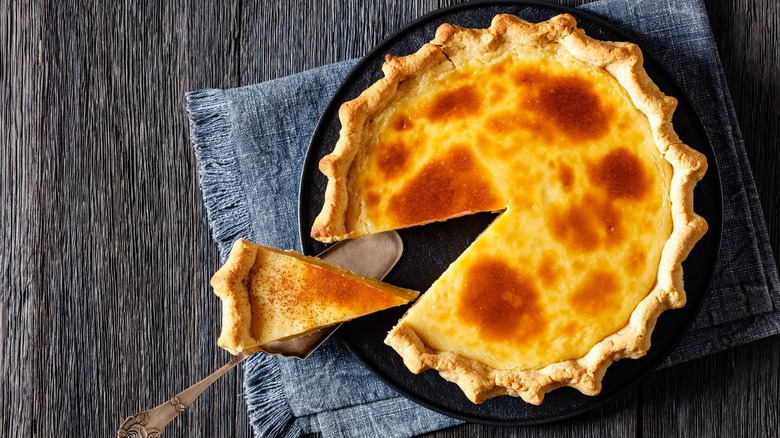
from my point of view/Shutterstock
Hoosiers, which is an endearing term for Indiana residents, take deep pride in their namesake pie. Hoosier pie is another word for sugar cream pie, which can be found primarily and thoroughly in Indiana and is often considered the unofficial state dessert. Grocery stores are loaded with the pie, and it's commonplace at functions, in home kitchens, and at local mom-and-pop restaurants as well.
This pie has a simple creamy filling and a basic pastry crust. After baking the two together until the crust is golden and the filling is hot, the pie is sometimes sprinkled with a dusting of cinnamon before it's left to cool. It's an easy recipe that has stolen the heart of the Midwestern state.
The Hoosier pie has its origins in Indiana's Shaker and Amish communities. Unlike other once-popular pie flavors that aren't around much anymore, such as Shaker lemon pie, Hoosier pie has stood the test of time. This is likely due to the loyalty Hoosiers have to their local culture, and the fact that this simple pie is reflective of the state's no-fuss, friendly attitude.
Bumpy cake
While those unfamiliar with the Midwest may not have heard of bumpy cake, it's something that can commonly be found in grocery stores throughout the region. Bumpy cake is relatively simple, consisting of a chocolate cake with a healthy helping of frosting. Two to four lines of white frosting are piped on top of the cake before melted chocolate is poured over the entire dessert. This signature frosting technique is what makes a bumpy cake so recognizable.
Today, bumpy cake is widely made in Midwestern homes and is available to buy commercially. However, it actually started out in Detroit, Michigan, at a confectionery owned and operated by Fred Sanders. The bumpy cake craze started when the baker created a buttercream-topped chocolate devil's food cake and didn't have enough buttercream. His solution was to pipe buttercream ridges on the devil's food cake and pour ganache over the sparse topping. The makeshift dessert was well received, and it remains so today.
Bumpy cake is still very much a Midwestern dessert, but it has spread throughout the world since Sanders' 1912 creation. Sanders Candy still makes bumpy cake to this day, receiving orders from all over the world, and has even introduced carrot and vanilla variations.
Gooey butter cake
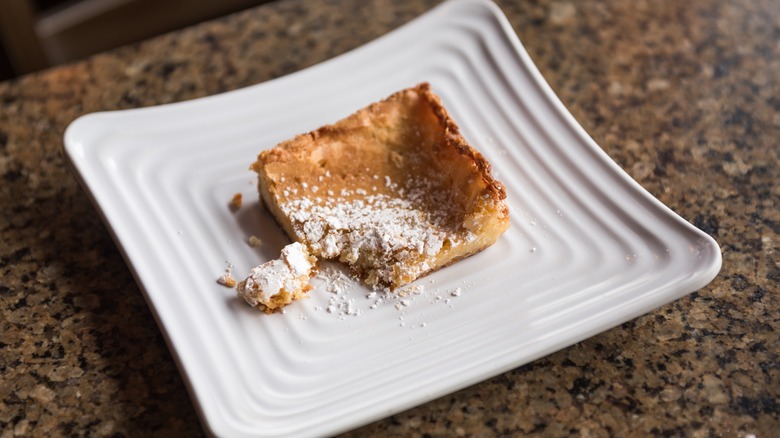
Sandra Foyt/Shutterstock
St. Louis is probably best known for its Gateway Arch, but it should get more credit for being the birthplace of multiple sweet treats. Iconic dessert sidekicks like waffle cones and Reddi-wip were born in this Midwestern city, but so was gooey butter cake. Gooey butter cake is a chewy, rich cake that doesn't actually look like a cake at all. At just an inch or so tall, this sheet cake resembles blondie brownies more than the cakes you're likely used to.
While gooey butter cake may look like a pan of lightly colored brownies, its texture and makeup are something else entirely. This dessert's main component is its two layers, the first of which is a dense, butter-rich cake. The second layer is where it gets its namesake gooey texture, which consists of even more butter and, in some recipes, cream cheese. Ideally, the dessert has two defined, different-textured layers upon completion.
It is said that gooey butter cake was first created in St. Louis in the 1930s when a baker added too much butter to their intended coffee cake. The result was an oddly sticky sheet cake that soon spread in popularity and has stood the test of time in the Midwest.
Kringle
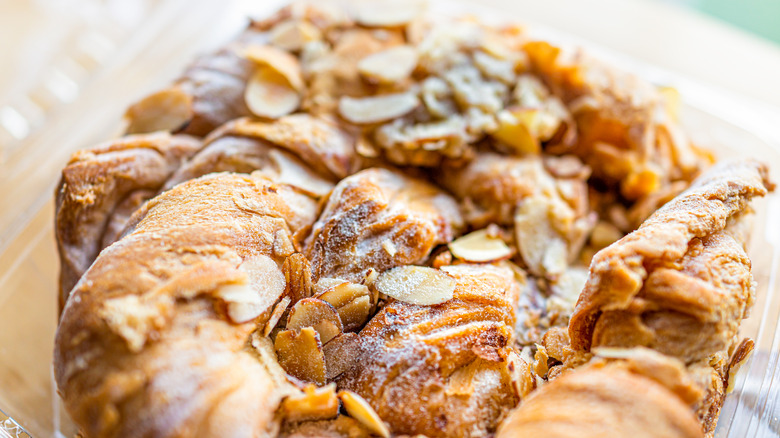
Krblokhin/Getty Images
Another cultural dessert inspired by immigrants who flocked to the Midwest is kringle, which is a gorgeous stuffed pastry that is popular around the holidays. The unique dessert has its roots in Danish culture but stands strong in American culture as Wisconsin's state pastry. Traditionally, kringle is an artisan dessert. The pastry is folded into a beautifully arranged oval of thinly layered dough, which is then sometimes decorated and displayed for gatherings.
Kringle tastes like the holidays, and for those who grew up with the dessert as tradition, it likely tastes a bit like home, too. The braided dough can contain a variety of fillings, so the actual taste of kringle is dependent on the whims of the maker. Popular choices are almond, apple, pecan, cherry, raspberry, and a number of other fruits and nuts. The texture of kringle, though, is what really makes the dessert pop. The pastry is delicate and has a perfect balance of a flaky and melt-in-your-mouth feel.
Cream cheese mints
The packaged mints you find on fancy hotel room pillows or presented alongside restaurant checks have nothing on the Midwest's cream cheese mints. These delectable little sweets are fun, delicious, and customizable, not to mention super simple to make. The mints popped up in the Midwest at some point by the 1970s as a simpler after-dinner mint. The addition of cream cheese avoided the cooking process required for your standard mint. The affordability and ease with which the cream cheese mints were made provided Midwesterners with an after-dinner or church treat without the extra effort, which is likely why the recipe has prevailed for so long.
You just need a handful of ingredients — most of which you may already have on hand — to make cream cheese mints. Cream cheese, powdered sugar, and mint extract are pretty much the only ingredients required. Once finished, the treats can be stored for enjoyment over time or easily gifted. By using food coloring and any candy mold, the mints can be fully customized for events or holidays. In their most simple form, though, dots of the cream cheese and sugar mixture are placed on parchment paper and flattened slightly with a fork before being chilled. A word of warning: These desserts are almost all sugar and incredibly bingeable, so proceed with caution.
Scotcheroos
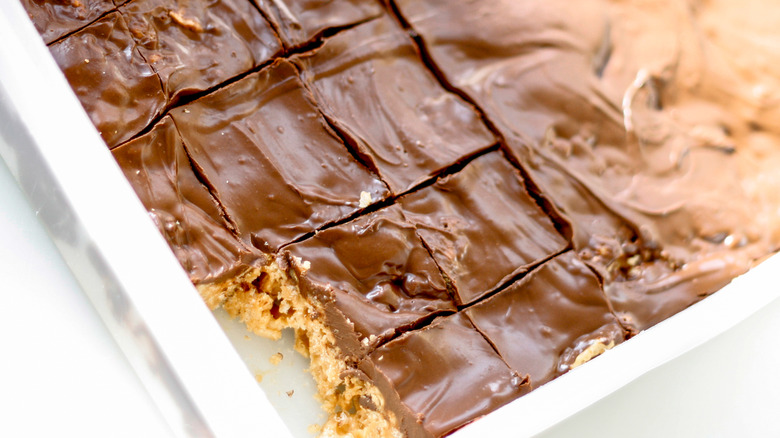
Lindsay Jubeck/Shutterstock
When you're low on energy and emotional spoons, a minimal effort dessert is of high value. No-bake desserts fit this bill if you have a little extra time. Scotcheroos are one of the most notable Midwestern no-bake desserts, particularly if you want to steer clear of Jell-O. They take very little time to prepare and taste great, making the chocolatey dessert a win-win.
Scotcheroos are made up of two layers, the bottom of which can be best described as a sweetened peanut butter Rice Krispies treat. This dense concoction is topped with a layer of melted butterscotch and chocolate. It's then left to cool, typically in a fridge. These are easy to serve in the same dish in which they were prepared, as well as pre-cut and arranged on a platter. Either way, scotcheroos are one of the go-to desserts for Midwesterners to bring to potlucks, school lunches, or really any gathering where food is a focus.
Unlike many other Midwestern desserts, scotcheroos weren't originally invented in a home kitchen, but instead came straight from a brand. Rice Krispies printed the original recipe right on the boxes of its products as an alternate version of the classic Rice Krispies treat, and the recipe has proven to have massive staying power for those in the region.
Jell-O salads
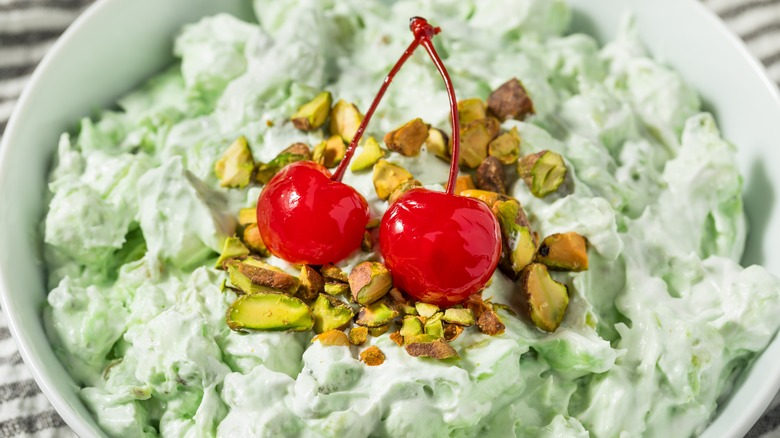
Brent Hofacker/Shutterstock
If you've ever watched "Parks and Recreation," you'll know that it's a running joke that residents of the Midwestern city of Pawnee, Indiana, generally have an aversion to salads. While it's played for laughs, the region's definition of a salad isn't always what you'd expect, with the Midwest's affinity for desserts with a Jell-O base extending to the existence of Jell-O salads.
These aren't salads in the traditional sense of the word, but a conglomeration of Jell-O and almost any other kind of ingredient, usually of the sweet variety. Jell-O salads come in seemingly all shapes, sizes, and flavors. Any type of Jell-O can be used, and any type of fruit, sweet, or, to an extent, vegetable, can be thrown in for good measure. One of the most iconic Jell-O salads is the Watergate salad, which is pistachio-flavored Jell-O instant pudding with pineapple, miniature marshmallows, and Cool Whip.
By definition, these Jell-O desserts can rightfully be called salads, even if we don't typically consider desserts to be included in that category. A salad can be defined as a dish made up of a mix of foods, no matter what those foods happen to be. Whether you love the thought of Jell-O salad or hate it, there's no denying its creativity.
Poke cakes
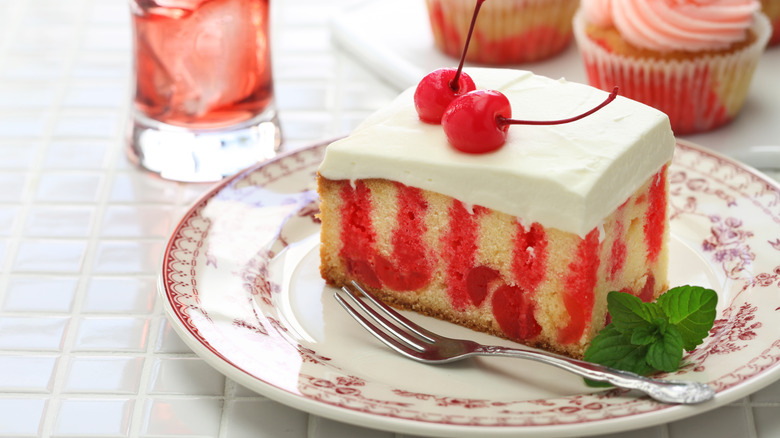
Bonchan/Getty Images
Poke cakes are another Jell-O dessert creation that has a chokehold on Midwesterners. This cake has a very fitting name, as it is quite literally a sheet cake with holes poked through it every few inches and topped with Jell-O. The toothpick (or any other similarly shaped poking device, such as a fork) holes act as a conduit for the Jell-O to infuse the cake. Pudding or syrups can also be substituted for Jell-O. Whatever you use, poke cakes are the secret to great flavor distribution and the masters of moistness.
You can make poke cakes with or without frosting. Even when they are iced, the flavor infusion can be seen when the cake is cut, typically in squares. One of the great things about these cakes is their simplicity, with no fancy gadgets or techniques required. Another perk of this cake is that it can be made in pretty much any flavor, or even utilize a combination of flavors.
If you look up poke cake recipes, you'll get pages of unique and interesting flavor combinations. At its heart, though, a poke cake is a very simple sheet cake that infuses flavor from Jell-O. Bakers can get as creative as they'd like with poke cakes, and the result will still be rooted in the typical Midwestern kitchen of the 1970s and 1980s.



